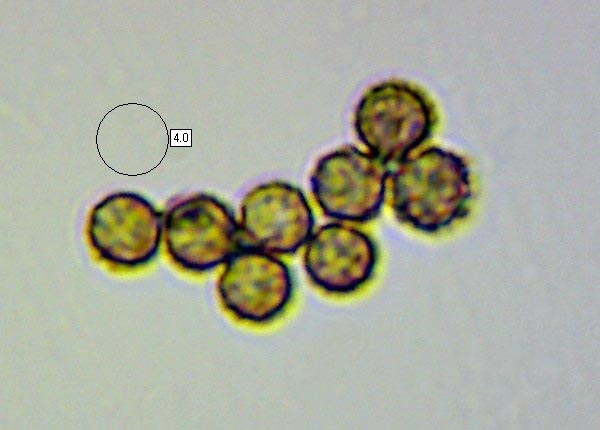Geastrum triplex Jungh. - Collared Earthstar
Phylum: Basidiomycota - Class: Agaricomycetes - Order: Geastrales - Family: Geastraceae
Distribution - Taxonomic History - Etymology - Identification - Culinary Notes - Reference Sources
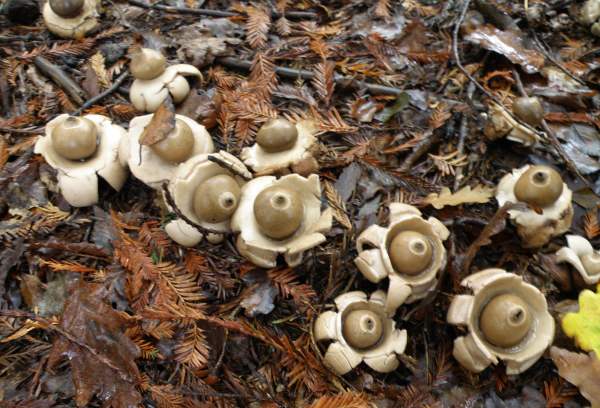
Look in woodland for this member of the (hopelessly jumbled, taxonomically, but useful from an identification point of view) gastromycetes group of fungi. Collared Earthstars are most often found under hardwood trees, but we have also found them in coniferous woodland, particularly with firs and spruces.
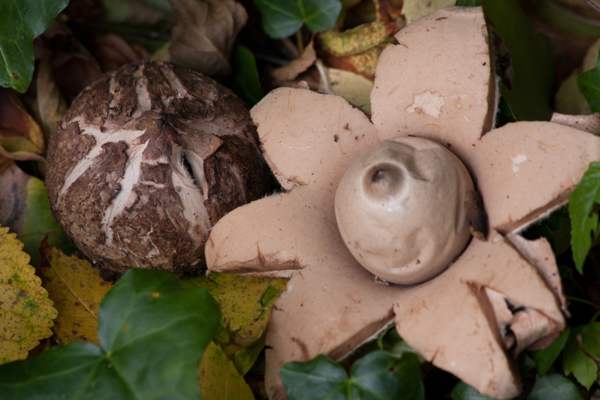
If you cut through a young fruitbody the interior is white, but it gradually turns into a dark brown powdery mass as the spores mature.
Spores are emitted from the apical hole as breezes blow across it, and much larger puffs of spores escape when raindrops hit and compress the spore-sac.
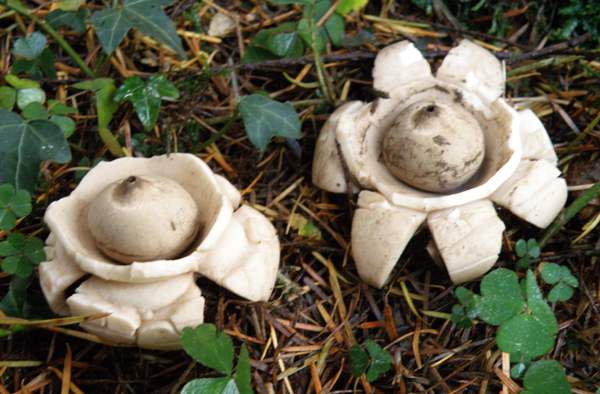
Distribution
From mid summer through to winter and often into the following spring the Collared Earthstar can be seen in Britain and Ireland, although it is an infrequent and rather localised species. This earthstar occurs also in most parts of central and northern mainland Europe and in many other regions of the world including North America.
Taxonomic history
The Collared Earthstar was described scientifically by German botanist Franz Wilhelm Junghuhn (1809 - 1864) in 1840 and given the binomial scientific name Geaster triplex. Geaster and Geastrum are considered synonymous, and the currently-accepted scientific name Geastrum triplex is therefore accredited to Junghuhn.
Synonyms of Geastrum triplex include Geastrum saccatum Fr., and Geastrum michelianum W.G. Sm.
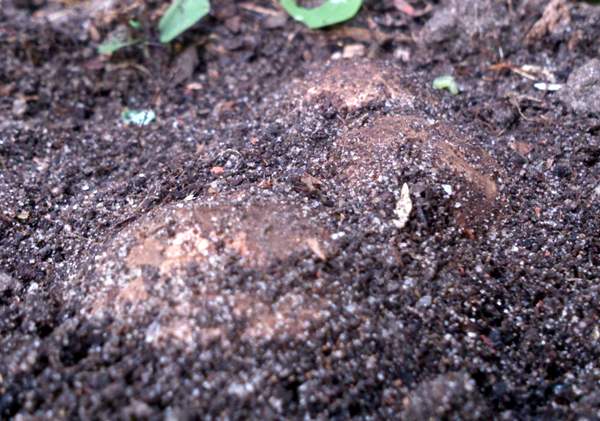
Etymology
Geastrum, the generic name, comes from Geo- meaning earth, and -astrum meaning a star. Earthstar it is, then.
The specific epithet triplex is quite straightforward and simply means 'having three layers' - a three-ply structure.
In its 'egg' stage the Collared Earthstar is very difficult to identify; it looks quite similar to many other members of the gasteromycetes group of fungi. The picture above, showing 'eggs'of the Collared Earthstar Geastrum Triplex, was taken in August 2013, but it was early October before the rays opened fully and the collar formed to reveal its true identity.
Identification guide
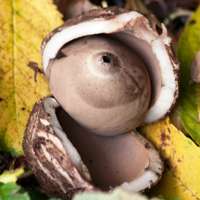 |
FruitbodyCollared Earthstars are larger than other earthstar species, and they have a spore-sac diameter up to 5cm and arms that span twice that distance when fully outstretched. A flattened spherical spore-sac holds the powdery gleba with which the spores are distributed. |
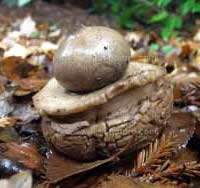 |
As with other earthstars, the bulb is mounted on a star-shaped base, but Geastrum triplex is commonly referred to as the Collared Earthstar because in many instances the arms crack as they bend, with the result that the spore-sac seems to be sitting on a separate saucer-like layer. There is no stem. The number of star rays is very variable - those illustrated on this page have six or seven rays but some found nearby had only five rays. |
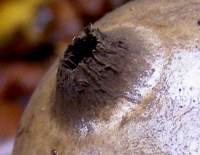 |
A pointed hole, known as a peristome (see left), on the top of the sac releases spores when the wind blows across it or raindrops impinge upon it. The sides of the peristome are fibrous and appear rather ragged but not regularly striate, and the peristome is surrounded by a fuzzy ring slightly paler fawn-brown than the rest of the spore-sac outer surface. |
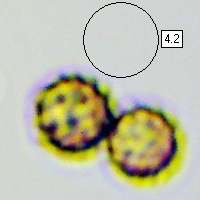 |
SporesGlobose, 3.5-4.5µm in diameter; covered in small spiny warts.
Spore massDark brown. |
Odour/taste |
Not noticeable. |
Habitat |
Found under hardwood and coniferous trees, often on sloping rather than flat ground |
Season |
Fruiting after rain in late summer and autumn; visible all year round. |
Similar species |
Several other Geastrum species, including Geastrum saccatum (see below) are of the same general form, although generally smaller, and confident identification requires a lot of expertise. |
Culinary Notes
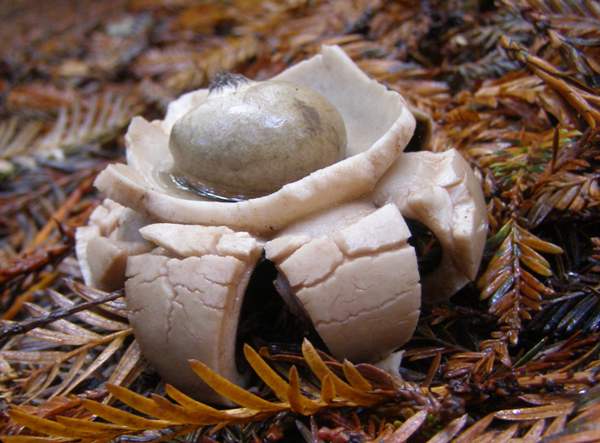
Earthstars are inedible and have no culinary value, but when dried they can make attractive table decorations as long as they do not get mistaken for pepper shakers!.
Reference Sources
Fascinated by Fungi, 2nd Edition, Pat O'Reilly 2016, reprinted by Coch-y-bonddu Books in 2022.
Ellis JB, Ellis MB. (1990). Fungi without Gills (Hymenomycetes and Gasteromycetes): an Identification Handbook. London: Chapman and Hall. ISBN 0-412-36970-2.
Pegler, D.N., Laessoe, T. & Spooner, B.M (1995). British Puffballs, Earthstars and Stinkhorns. Royal Botanic Gardens, Kew.
Dictionary of the Fungi; Paul M. Kirk, Paul F. Cannon, David W. Minter and J. A. Stalpers; CABI, 2008
Taxonomic history and synonym information on these pages is drawn from many sources but in particular from the British Mycological Society's GB Checklist of Fungi.
Below: A Geastrum species, probably Geastrum saccatum, in Tijuca's National Forest in Rio de Janeiro, Brazil, in a reconstructed forest of what is called there 'bioma mata atlantica'. Picture and details kindly contributed by Rogerio Dias.
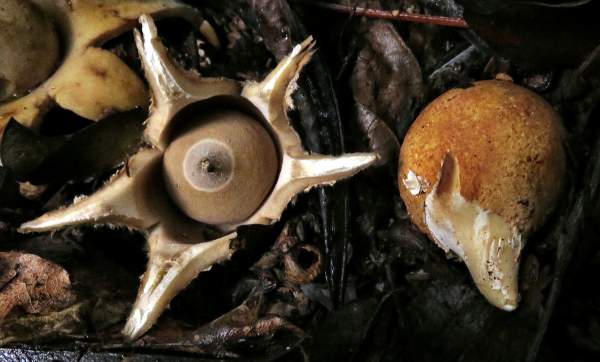
Geastrum saccatum
in 1829 Geastrum saccatum was described by Swedish mycologist Elias Magnus Fries, but European mycologists later concluded that Geastrum triplex and Geastrum saccatum were synonyms - two names for the same species - and Geastrum triplex is the currently accepted name here in Britain. The mycological experts at Kew (London), whose naming system I follow on First Nature, still treat these two names as synonymous; however, at present the fungus records database for Britain and Ireland recognises very few species in the Geastrum genus.
In a recent (2014) publication Japanese and Spanish mycologists have concluded from DNA studies that there are probably some 120 different Geastrum species, and they separate out Geastrum triplex and Geastrum saccatum as two distinct species. (Geastrum langeniforme is also macroscopically very similar but genetically distinct from these two.) Without studying these earthstars microscopically, it is not possible to distinguish between Geastrum triplex and Geastrum saccatum for certain. (Both species are reported to occur in Brazil.)
Geastrum triplex often splits to display a collar, but not always. I have found colonies here in the UK where some specimens have split and others have not split to form collars. One thing that can help is knowing the size of the spore sac (the central globe). In the USA where both species are recognised as separate the average size for Geastrum triplex is recorded as 1 - 5 cm wide (average 3cm), while for Geastrum saccatum a size range of 2 - 3cm (average 2.5cm) is quoted. There are also some microscopic differences in hyphal structures (known as capillitial threads) inside the spore mass, but again an overlap in their ranges. The spore sizes and ornamentation are much the same for both.
Acknowledgements
This page includes pictures kindly contributed by Barbara Corish, Rogerio Dias, Simon Harding and Beverley Stafford.
Fascinated by Fungi. Back by popular demand, Pat O'Reilly's best-selling 450-page hardback book is available now. The latest second edition was republished with a sparkling new cover design in September 2022 by Coch-y-Bonddu Books. Full details and copies are available from the publisher's online bookshop...

